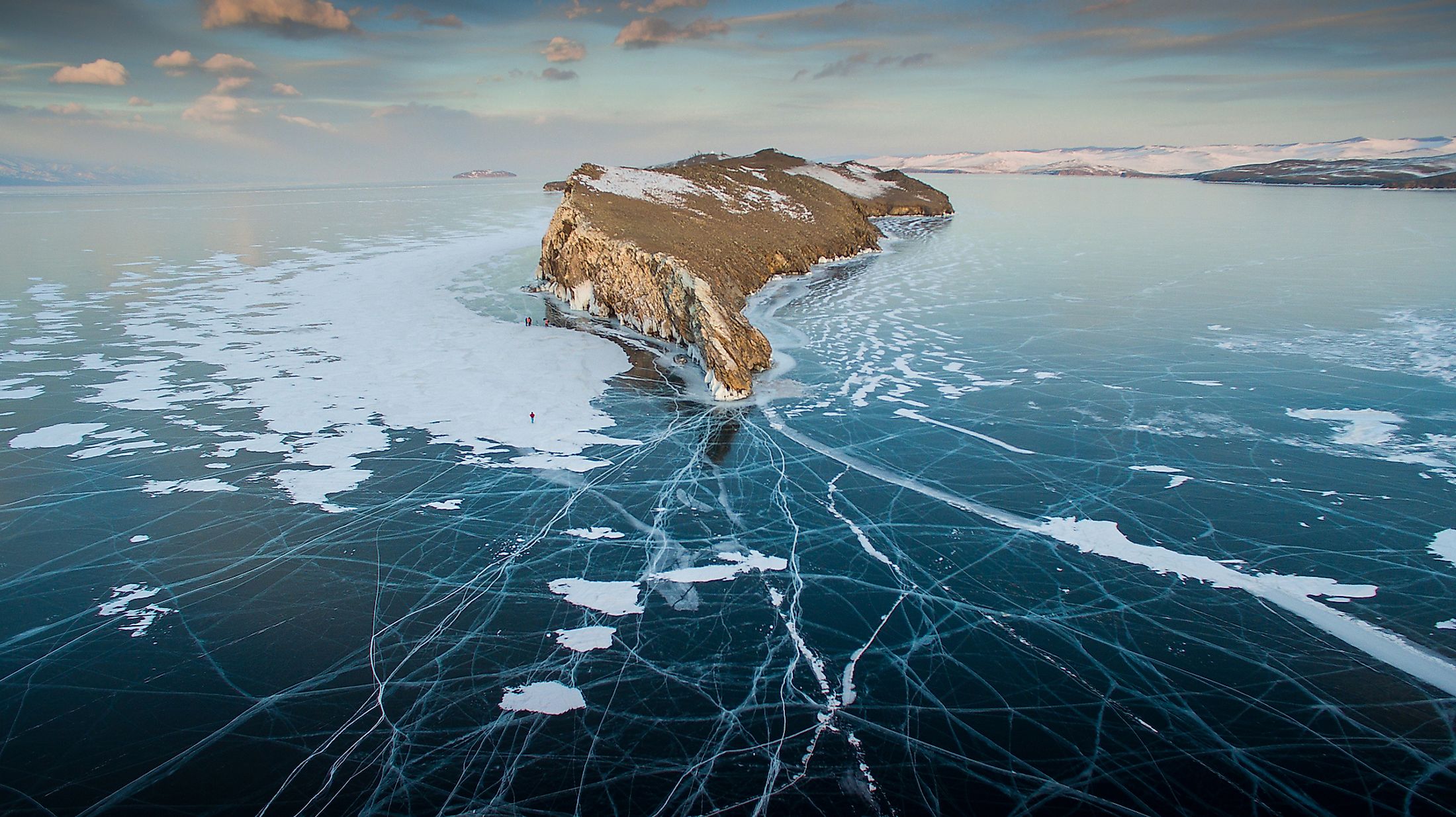
The Largest Freshwater Lakes In The World
A Lake is defined as a large body of water that is surrounded by land apart from the streams and rivers that feed or drain the lake. Most of the world’s lakes contain not less than one natural outflow in the form of a river or a stream, which helps to maintain the water level of the lake by draining the lake’s excess water. However, some lakes do not possess any natural outflow and therefore lose the excess water by both evaporation and underground seepage. The lakes vary greatly in size and depth and are found in a wide variety of habitats and at different elevations.
Most of the planet’s freshwater lakes are situated at higher latitudes in the Northern Hemisphere. It has been estimated that there are at least 2 million lakes in Canada, out of which 31,752 lakes are larger than 3 sq. km and 591 lakes are more than 100 sq. km.
10 Largest Fresh Water Lakes
- Lake Superior – 82,103 sq.km
- Lake Victoria – 59,947 sq.km
- Lake Huron – 59,588 sq. km
- Lake Michigan – 58,030 sq. km
- Lake Tanganyika – 32,900 sq. km
- Lake Baikal – 31,722 sq. km
- Great Bear Lake – 31,153 sq. km
- Lake Malawi -29,600 sq.km
- Great Slave Lake – 27,200 sq. km
- Lake Erie – 25,667 sq.km
1. Lake Superior – 82,103 km2

Lake Superior covers an area of about 82,103 sq. km and is the largest of the five Great Lakes of North America as well as the largest freshwater lake in the world by surface area. Lake Superior is also the third-largest lake by volume and holds about 10% of the surface freshwater of the world. The lake has a length of 560km and a maximum width of 260km. It reaches a maximum depth of 406m and has an average depth of 147m. Lake Superior is situated at the extreme northwestern end of the Great Lakes chain and is shared by the Canadian province of Ontario and the US States of Wisconsin, Minnesota, and Michigan’s Upper Peninsula. More than 200 rivers drain into Lake Superior and the waters of the lake empty into Lake Huron through the St. Mary’s River. Many islands like Apostle Islands, Slate Islands, Isle Royale, Michipicoten Island, etc are located within Lake Superior.
2. Lake Victoria – 59,947 km2
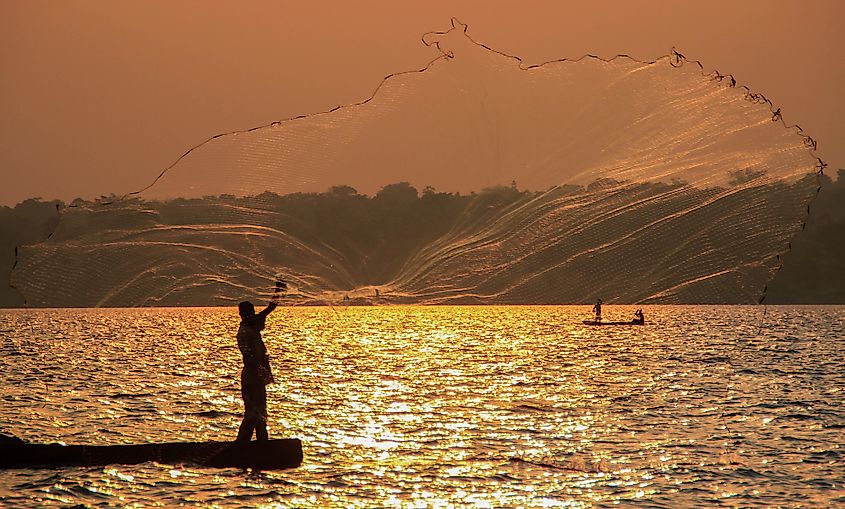
Lake Victoria covers an area of about 59,947 sq. km and is the world’s biggest tropical lake and the largest lake on the African continent. After Lake Superior, Lake Victoria is considered the second-largest freshwater lake on the planet. Lake Victoria is one of Africa’s Great Lakes and was named by the British Indian Army officer and explorer John Hanning Speke in the honor of Queen Victoria. The huge area of Lake Victoria is shared by the African nations of Tanzania (49%), Uganda (45%), and Kenya (6%). This large irregular-shaped lake serves as the chief reservoir of the River Nile and has a length of 359km and a maximum width of 337km. Lake Victoria is however relatively shallow and reaches a maximum depth of 81m and an average depth of 41m. Many rivers flow into Lake Victoria and the waters of the lake drain out via Victoria Nile at the northern shore of the lake. Many islands like Rusinga, Ukerewe, Maboko, etc are located in Lake Victoria.
3. Lake Huron – 59,588 km2

Lake Huron covers an area of about 59,588 sq. km and is the second-largest of the five Great Lakes of North America as well as the third-largest freshwater lake in the world by surface area. Lake Huron is situated in the eastern part of Lake Michigan-Huron and is shared by the US State of Michigan and the Canadian province of Ontario. The lake has a length of 332km and a maximum width of 295km. Lake Huron reaches a maximum depth of 229m and an average depth of 59m. Manitoulin Island is the world’s largest freshwater island that is located in Lake Huron.
4. Lake Michigan – 58,030 km2

Lake Michigan covers an area of about 58,030 sq. km and is the third-largest of the five Great Lakes of North America as well as the fourth largest freshwater lake in the world by surface area. Lake Michigan occupies the western part of Lake Michigan-Huron and is situated entirely within the boundaries of the United States. The lake has a length of 494km and a maximum width of 190km. Lake Michigan reaches a maximum depth of 281m and an average depth of 85m. The Straits of Mackinac connects Lake Michigan with Lake Huron.
5. Lake Tanganyika – 32,900 km2
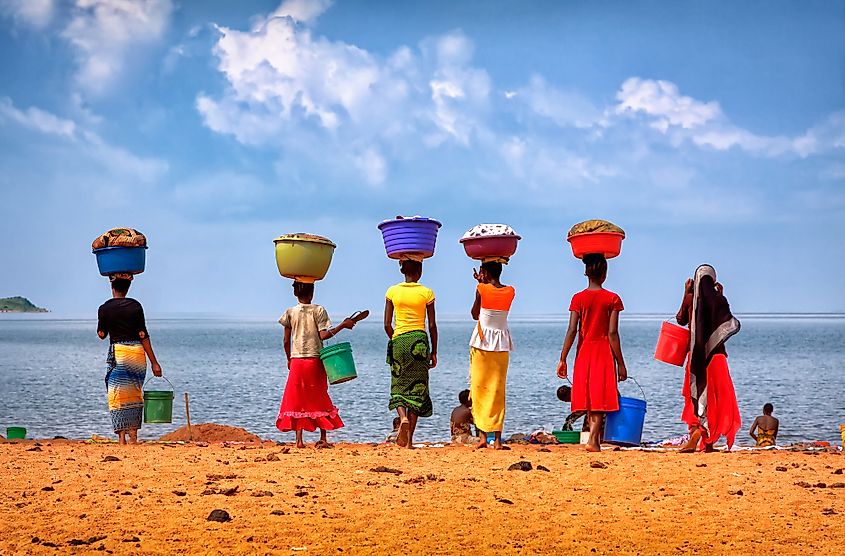
Lake Tanganyika covers an area of 32,900 sq. km and is an African Great Lake which is also the longest freshwater lake in the world. It is also the world’s second-largest freshwater lake by volume and the second-oldest freshwater lake. Lake Tanganyika is shared by the African countries of Tanzania, the Democratic Republic of the Congo, Zambia, and Burundi. Lake Tanganyika is also Africa’s largest rift lake as well as the deepest lake that reaches a maximum depth of 1,470m. Several rivers like the Ruzizi River, Malagarasi River, Kalambo River drain into Lake Tanganyika, while the waters of the lake flow out via the Lukuga River into the Congo River system and finally into the Atlantic Ocean. Some of the notable islands in Lake Tanganyika include Kavala, Mamba-Kayenda, Milima, Kumbula Island etc.
6. Lake Baikal – 31,722 km2

Lake Baikal covers an area of 31,722 sq. km and is the largest freshwater lake in the world by volume, which accounts for about 23% of the entire planet’s freshwater. This rift lake is situated in the southern part of Siberia and is bordered by Russia’s Irkutsk Oblast in the northwest and the Buryat Republic in the southeast. Lake Baikal has a length of 636km and a maximum width of 79km. It is considered the deepest lake in the world that reaches a maximum depth of 1,642m and has an average depth of 744.4m. Some of the rivers that flow into Lake Baikal include Sarma, Selenga, Turka, Barguzin etc. The waters of the lake drain out via the Angara River. In 1996, Lake Baikal was designated as a World Heritage Site by UNESCO.
7. Great Bear Lake – 31,153 km2
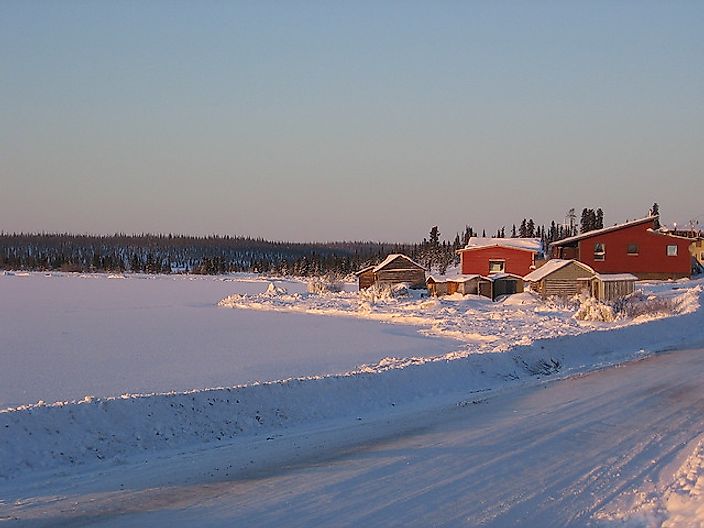
Great Bear Lake covers an area of 31,153 sq. km and is North America’s fourth-largest lake. This irregularly-shaped lake is also the largest in Canada and is located entirely within its borders. Great Bear Lake is situated in the Northwest Territories on the Arctic Circle. The lake reaches a maximum depth of 446m and has an average depth of 71.7m. Some of the rivers that flow into the Great Bear Lake include the Haldane River, Whitefish River, Bloody River, Big Spruce River, etc. The waters of the lake drain out via the Great Bear River that ultimately drains into the Mackenzie River.
8. Lake Malawi -29,600 km2

Lake Malawi is an African Great Lake that covers an area of 29,600 sq. km and is also the third-largest lake in Africa. The lake is situated on the Tanzania-Mozambique-Malawi border and is referred to as “Lago Niassa” in Mozambique and “Lake Nyasa” in Tanzania. Lake Malawi has a length of 560-580km and a maximum width of 75km. It is the world’s sixth-deepest and Africa’s second deepest lake that reaches a maximum depth of 706m and an average depth of 292m. Several rivers and streams drain into Lake Malawi of which the Ruhuhu River is the largest. The waters of the lake drain out via the Shire River that eventually drains into the Zambezi River.
9. Great Slave Lake – 27,200 km2
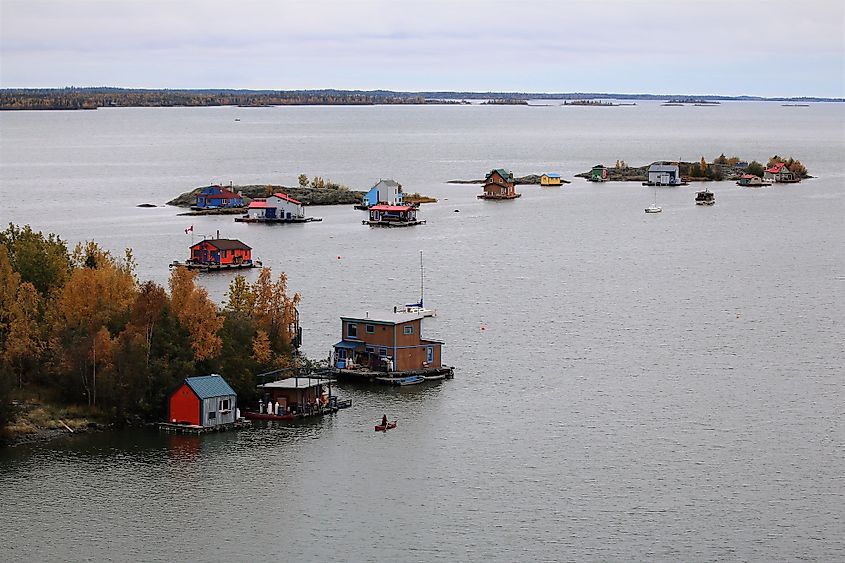
Great Slave Lake covers an area of 27,200 sq. km and is the second-largest lake in Canada’s Northwest Territories, which is located entirely within the country’s borders. This irregularly-shaped lake has a length of about 469km and a maximum width of 203km. Great Slave Lake is North America’s deepest lake that reaches a maximum depth of 614m and an average depth of 41m. Some of the major rivers that drain into the Great Slave Lake include the Slave River, Hay River, Lockhart, Taltson, Yellowknife, etc. The waters of the lake flow out via the Mackenzie River.
10. Lake Erie – 25,667 km2

Lake Erie covers an area of about 25,667 sq. km and is the fourth-largest of the five Great Lakes of North America as well as the smallest lake by volume. Lake Erie is also the southernmost of the Great lakes and is shared by the Canadian province of Ontario and the US States of Michigan, Ohio, Pennsylvania, and New York. The lake has a length of 388km and a maximum width of 92km. This shallow lake reaches a maximum depth of 64m and an average depth of 19m. Several rivers like the Detroit River, Grand River, Huron River, Buffalo River, etc flow into Lake Erie, while the waters of the lake drain out via the Niagara River.
The above article focuses on the 10 largest freshwater lakes in the world. As noted in the above discussion, most of these large lakes are found in the continent of North America, while few of these large lakes are found in the continents of Africa and Asia. The freshwater lakes also sustain several flora and fauna and provide humankind with numerous benefits. However, the majority of these freshwater lakes are threatened by various anthropogenic activities that have led to the deterioration in the water quality of the lakes.
25 Largest Fresh Water Lakes By Area
| Rank | Name | Surface area | Water volume |
|---|---|---|---|
| 1 | Superior | 82,100 km2 (31,700 sq mi) | 11,600 km3 (2,800 cu mi) |
| 2 | Victoria | 68,800 km2 (26,600 sq mi) | 2,700 km3 (650 cu mi) |
| 3 | Huron | 59,600 km2 (23,000 sq mi) | 3,540 km3 (850 cu mi) |
| 4 | Michigan | 58,000 km2 (22,000 sq mi) | 4,920 km3 (1,180 cu mi) |
| 5 | Tanganyika | 32,900 km2 (12,700 sq mi) | 18,900 km3 (4,500 cu mi) |
| 6 | Baikal | 31,722 km2 (12,248 sq mi) | 23,600 km3 (5,700 cu mi) |
| 7 | Great Bear | 31,153 km2 (12,028 sq mi) | 2,236 km3 (536 cu mi) |
| 8 | Malawi | 29,600 km2 (11,400 sq mi) | 7,725 km3 (1,853 cu mi) |
| 9 | Great Slave | 27,200 km2 (10,500 sq mi) | 1,580 km3 (380 cu mi) |
| 10 | Erie | 25,667 km2 (9,910 sq mi) | 488 km3 (117 cu mi) |
| 11 | Winnipeg | 24,514 km2 (9,465 sq mi) | 294 km3 (71 cu mi) |
| 12 | Ontario | 18,960 km2 (7,320 sq mi) | 1,710 km3 (410 cu mi) |
| 13 | Ladoga | 17,891 km2 (6,908 sq mi) | 912 km3 (219 cu mi) |
| 14 | Vostok | 15,690 km2 (6,060 sq mi) | ~5,400km³ (~1,300 cu mi) |
| 15 | Onega | 9,700 km2 (3,700 sq mi) | 291 km3 (70 cu mi) |
| 16 | Titicaca | 8,372 km2 (3,232 sq mi) | 896 km3 (215 cu mi) |
| 17 | Nicaragua | 8,264 km2 (3,191 sq mi) | 110 km3 (26 cu mi) |
| 18 | Athabasca | 7,850 km2 (3,030 sq mi) | 204 km3 (49 cu mi) |
| 19 | Reindeer | 6,650 km2 (2,570 sq mi) | 113 km3 (27 cu mi) |
| 20 | Vänern | 5,650 km2 (2,180 sq mi) | 153 km3 (37 cu mi) |
| 21 | Nettilling | 5,542 km2 (2,140 sq mi) | 130 km3 (31 cu mi) |
| 22 | Albert | 5,300 km2 (2,000 sq mi) | 133 km3 (32 cu mi) |
| 23 | Nipigon | 4,848 km2 (1,872 sq mi) | 266 km3 (64 cu mi) |
| 24 | Khövsgöl | 2,760 km2 (1,070 sq mi) | 381 km3 (91 cu mi) |
| 25 | Kivu | 2,700 km2 (1,000 sq mi) | 648 km3 (155 cu mi) |











